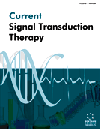- Home
- A-Z Publications
- Current Signal Transduction Therapy
- Previous Issues
- Volume 3, Issue 2, 2008
Current Signal Transduction Therapy - Volume 3, Issue 2, 2008
Volume 3, Issue 2, 2008
-
-
Liver X Receptor: Crosstalk Node for the Signaling of Lipid Metabolism,Carbohydrate Metabolism, and Innate Immunity
More LessLiver X Receptor-α (LXRα, also known as NR1H3) and LXRβ (NR1H2) are members of the nuclear receptor superfamily of ligand-activated transcription factors, a superfamily which includes the more widely known glucocorticoid receptor, estrogen receptor, thyroid receptor, and peroxisome proliferator-activated receptors. The LXRs are activated by physiologic sterol ligands (e.g., oxysterols) and by synthetic agon Read More
-
-
-
The Role of Parthenolide in Intracellular Signalling Processes: Review of Current Knowledge
More LessAuthors: Luis M. Bedoya, Maria Jose Abad and Paulina BermejoThe popularity of medicinal herbs has grown significantly in recent years despite a dearth of information regarding their modes of action and continuing concerns over their efficacy. Recent efforts to elucidate the mechanisms of action of several anti-inflammatory herbs have focused on a class of compounds, sesquiterpene lactones, that are believed to be the active components of these herbal medicines. Sesquiterpene la Read More
-
-
-
Intracellular Signaling Triggered by Formyl-Peptide Receptors in Nonphagocytic Cells
More LessAuthors: Annalisa Iaccio, Antonella Angiolillo and Rosario AmmendolaFormyl-peptide receptors (FPR) are expressed in several cell types including phagocytic leukocytes, and a wide variety of agonists of FPR and of its FPRL1 variant have been identified. These ligands interact with their specific receptors on the cellular membrane, and activate specific biological functions through a G-protein-coupled pathway. In nonphagocytic cells, agonist/FPR binding also induces transactivation of the constituti Read More
-
-
-
Novel Therapeutic Targets for the Treatment of Tubulointerstitial Fibrosis
More LessAuthors: Jai Prakash, Klaas Poelstra, Harry v. Goor, Frits Moolenaar, Dirk K.F. Meijer and Robbert J. KokApproximately 80% of the kidney is composed of tubular cells which secret and reabsorb substances to and from the urine. Activated tubular cells play a pivotal role in the etiology of renal fibrosis. During renal injury, these activated tubular cells participate in the initiation of fibrogenic processes which eventually may lead to tubulointerstitial fibrosis and end stage renal disease (ESRD). Current therapies such as angiote Read More
-
-
-
Signal Transduction Targets in Prostate Cancer
More LessAuthors: Hari K. Koul and Lakshmipathi KhandrikaAccording to the American Cancer Society, Prostate cancer (PCa) is the second leading cause of cancer deaths in men. Conventional therapies produce a high rate of cure for patients with localized prostate cancer, but there is no cure once the disease has spread beyond the prostate. Androgens are the primary growth factors used by prostate cancer cells initially, and androgen deprivation remains the only treatment f Read More
-
-
-
LGI1 Affects Survival of Neuroblastoma Cells by Inhibiting Signalling through Phosphoinositide 3-Kinase
More LessAuthors: Nadia Gabellini and Valentina MasolaOverexpression of the leucine-rich, glioma-inactivated 1 (LGI1) gene in neuroblastoma cells inhibited proliferation and efficiently induced apoptosis. Cell clones stably transfected with LGI1 cDNA showed greater mortality during a period of serum starvation in comparison with control cells stably transfected with empty vector. This observation suggested hindrance of the PI3K/Akt pathway, a central transducer of survival stimuli eli Read More
-
-
-
Pathogen-Related Signal Transduction Pathways of Dendritic Cells: Perspectives for Cancer Immunotherapy
More LessAuthors: Tomonori Kato, Yasuji Ueda, Hiroaki Kinoh, Kaori Tsukada, Tomohiko Ichikawa and Yoshikazu YonemitsuDendritic cells (DCs) play a crucial role in translating innate to adaptive immunity. DC-based cancer immunotherapy has been under evaluation; however, its clinical benefits remain limited. A better understanding of DCs is, therefore, needed to improve clinical outcomes. Toll-like receptors (TLRs) were initially identified as molecules that recognize and bind pathogen-associated molecular patterns (PAMPs) leading to DC mat Read More
-
-
-
Regulation of the PI3K-Akt Network: Current Status and a Promise for the Treatment of Human Diseases
More LessAuthors: Masayuki Noguchi, Toshiyuki Obata and Futoshi SuizuThe growth factor signals regulate the balance of cell proliferation and cell death to maintain the homeostasis in vivo; hence, deregulation of the balance underlies a variety of human diseases. The PI3K-Akt network is activated by various cytokines or growth factors and mediates intracellular signals to regulate a wide variety of cellular responses, including anti-apoptosis, proliferation, cell cycling, protein synthesis, glucose met Read More
-
Volumes & issues
-
Volume 20 (2025)
-
Volume 19 (2024)
-
Volume 18 (2023)
-
Volume 17 (2022)
-
Volume 16 (2021)
-
Volume 15 (2020)
-
Volume 14 (2019)
-
Volume 13 (2018)
-
Volume 12 (2017)
-
Volume 11 (2016)
-
Volume 10 (2015)
-
Volume 9 (2014)
-
Volume 8 (2013)
-
Volume 7 (2012)
-
Volume 6 (2011)
-
Volume 5 (2010)
-
Volume 4 (2009)
-
Volume 3 (2008)
-
Volume 2 (2007)
-
Volume 1 (2006)
Most Read This Month
Article
content/journals/cst
Journal
10
5
false
en


